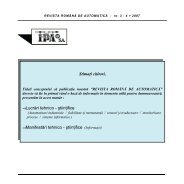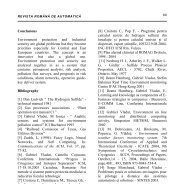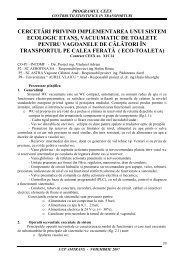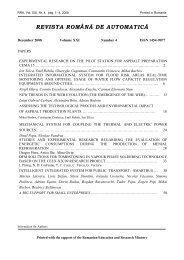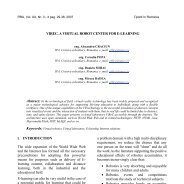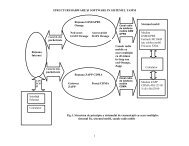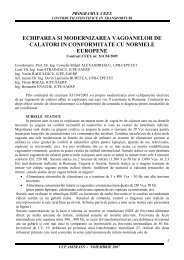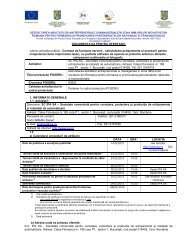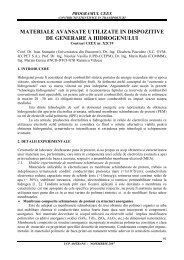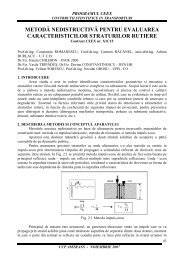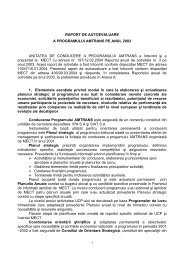0_ CUPRINS - IPA SA
0_ CUPRINS - IPA SA
0_ CUPRINS - IPA SA
You also want an ePaper? Increase the reach of your titles
YUMPU automatically turns print PDFs into web optimized ePapers that Google loves.
Some technical solutions related to integration of PV<br />
Modules in Existing Romanian Buildings<br />
Silvian Fara 1 , Dumitru Finta 1 , Mihai Iancu 1 , Laurentiu Fara 2 , Dragos Comaneci 3 , Ana-Maria Dabija 3 , Eugenia<br />
Tulcan- Paulescu 4 , Marius Paulescu 4 , Traian Jurca 5<br />
1 <strong>IPA</strong> <strong>SA</strong> Bucharest; 2 University ‘Politehnica’ Bucharest; 3 University of Architecture and Urbanism ‘Ion Mincu’,<br />
Bucharest; 4 West University Timisoara; 5 Politehnical University of Timisoara<br />
Abstract - The paper is based on an on-going national research<br />
project focused on the promotion of new architectural concepts<br />
i.e. BIPV systems, which include active solar systems (PV<br />
generators) and solar tunnels. The advantages of using the<br />
distributed solar architecture are more remarkable in the case of<br />
large network-connected PV systems, such as the PV systems in<br />
the urban area, installed on building’s façades or roofs. Thus, in<br />
contrast to other EU states, in Romania there is no photovoltaic<br />
building construction branch, the limited number of isolated<br />
cases being not enough to argue the start if a photovoltaic market<br />
in the building industry. The major purpose of the project is to<br />
demonstrate the efficiency of integrating various PV elements in<br />
buildings, to test them and to make them known so that they can<br />
be used on a large scale. To do this, the new products will be<br />
installed on three pilot buildings (two in Bucharest and one in<br />
Timisoara) and the PV modules will be integrated in consonance<br />
with their architecture. One of them will be a historical building<br />
and the other two will be new buildings; they will have different<br />
typologies and they will be located in different areas. The installed<br />
power for each building will be of approximately 1.000 Wp,<br />
including some technologies with PV modules integrated in the<br />
architecture of the buildings.<br />
I. INTRODUCTION<br />
A. RES Policy<br />
In Romania the main policy instrument to support RES-E<br />
at national level is the quota system based on tradable green<br />
certificates (TGC) as introduced in 2004. The mandatory quota<br />
for electricity suppliers increases from 0.7% in 2005 to 8.3%<br />
in 2010. Wind, solar, biomass or hydro power generated in<br />
plants with less than 10 MW capacity (new or refurbished<br />
since 2004) are eligible for certificates. A minimum and<br />
maximum price for the TGCs is determined annually by the<br />
Romanian Energy Regulatory Authority (ANRE). A supplier<br />
who fails to fulfil his quota has to pay the maximum price – at<br />
least in theory. Arguing with the large imbalance between<br />
supply and demand for RES-E, it is the common practice of<br />
ANRE to adjust the quota at the end of each year to the amount<br />
of offered TGCs. This means for example that the quota for<br />
2008 was modified from 5.3% to 0.32% ex-post.<br />
Consequently, almost no penalties are paid. Obviously this<br />
reduces the effectiveness of the penalty and destroys the proper<br />
functioning of the overall RES trading scheme.<br />
In 2008 a new law was introduced, which stated important<br />
improvements on the existing regulations of the RES trading<br />
regime. However, no secondary legislation has yet been<br />
approved by the Government in order to make the law<br />
operational. An entry into force is expected for 2010. A key<br />
element of the new law is to establish technology-specific<br />
weighting factors in the RES trading system. Estimated<br />
development of electricity production from photovoltaics in<br />
Romania: for 2005 (0MW/0GWh); Average for 2011-2012<br />
(26MW/30GWh); Average for 2013-2014 (61MW/69GWh);<br />
Average for 2015-2016 (102MW/116GWh); Average for 2017-<br />
2018 (169MW/192GWh); 2020 (313MW/357GWh).<br />
At this moment, the necessity of the use of new forms of<br />
energy in Romania is politically stated. According to the<br />
proposal for a Directive of the European Parliament and of The<br />
Council on the promotion of the use of energy from renewable<br />
sources, given in Brussels in January 2008, there is an aim “to<br />
establish an overall binding target of a 20% share of renewable<br />
energy sources in energy consumption to be achieved by each<br />
Member State, as well as binding national targets by 2020 in<br />
line with the overall EU target of 20%”.<br />
Since 2005, a number of laws were elaborated and released<br />
by the Ministry of the Environment and Sustainable<br />
Development. The most recent Order, emitted in 2008, states<br />
that up to 90% of the costs of a solar system that is installed by<br />
a Local Authorities can be taken over by the Government. It is<br />
expected that the Order will stimulate the increase of the<br />
interest for solar systems. During the last few years, the users<br />
that have been emphasizing the possibilities opened by<br />
alternative energy sources increased. However, although we<br />
have regulations regarding energy efficiency in buildings and<br />
methodologies to evaluate the buildings, the actions that have<br />
been taken are mainly aiming to increase the thermal insulation<br />
of the envelope and to work on the installations within the<br />
building. A number of pilot projects have been carried out,<br />
during the past decade, alongside with building regulations that<br />
support the interventions. Not much has been done so far in<br />
terms of implementing solar energy systems. No building<br />
regulations regarding the use of PV systems exist so far.<br />
B. ”Solar Architecture”<br />
Solar Architecture is a general term which implies the<br />
integration of photovoltaic system into classical building design<br />
[1]. The key concept here is represented by the photovoltaic<br />
modules, which substitute some façade or roof components. For<br />
the design and construction of solar/PV systems it is necessary<br />
to have information about the solar energy collectable on tilted<br />
surfaces. In Romania, the meteorological stations have no such<br />
databases and do not perform such measurements. During the<br />
past 20 years the building activity has flourished in Romania.<br />
Along with the construction of new buildings – mainly<br />
residential parks and office buildings - the activity of<br />
12



